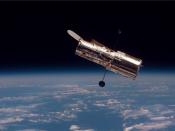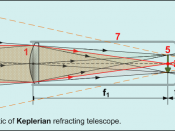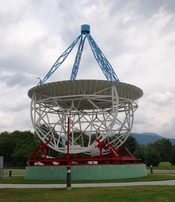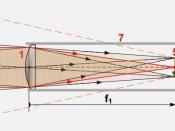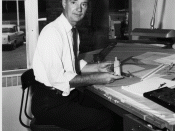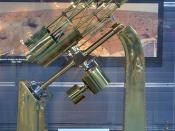The Hubble Telescope is the first major infrared-optical-ultraviolet telescope to be put into orbit around the Earth. The telescope gives us the clearest pictures of the Earth ever in mankind's history. The telescope is named after the American Astronomer Edwin P. Hubble. In the 1920's, he found galaxies beyond the Milky Way and discovered that the Earth was uniformly expanding.
The Reflecting Telescope: The Reflecting Telescope was constructed in 1913 and 1915. The telescope has a concave mirror at the end of its tube. The mirror receives light, focuses an image and reflects the image back to the eyepiece. The eyepiece is mounted on the side of the telescope so the viewer will not block the light path.
The Refracting Telescope: The Refracting Telescope uses a convex lens to collect light and focus an image. The eyepiece is mounted on the end of the telescope tube. When people think of a telescope, this is the one they usually have in mind.
In smaller sizes the Refracting telescope is usually less expensive than the Reflecting telescope.
The Radio Telescope: In the beginning of the Radio Telescope it was first built in 1937 by Grote Reber or Wheaton Ill., US. The Telescope was steer able paraboloid , it was a device with a parabolically shaped reflector. It was a dubbed dish that focuses the incoming radio waves onto a small pickup antenna, or "feed".
The X-Ray Telescope is an instrument designed to detect and resolve X-Rays from sources outside the Earth's atmosphere. Because of atmospheric absorption, X-Ray telescopes must be carried to high altitudes by rockets or balloons or be placed in orbit outside the atmosphere. Ballon-borne telescopes are used to detect the more penetrating (harder) X-Rays. Whereas those carried aloft by rockets or in satellites, they are used to detect softer radiation.
http://hubble.stsci.edu/sci.d.tech/discoveries/10th/telescope/allabout.shtml http://www.richland2.k12.sc.us/rce/telescop.htm http://www.britannica.com/bcom/eb/article/7/0,5716,63997+1+62417,00.html?query=radio%20telescope http://www.britannica.com/bcom/eb/article/8/0,5716,79748+1+77660,00.html?query=xray%20telescope http://www.nasm.edu/nasm/dsh/artifacts/SS-ReflectingTelescope.htm
